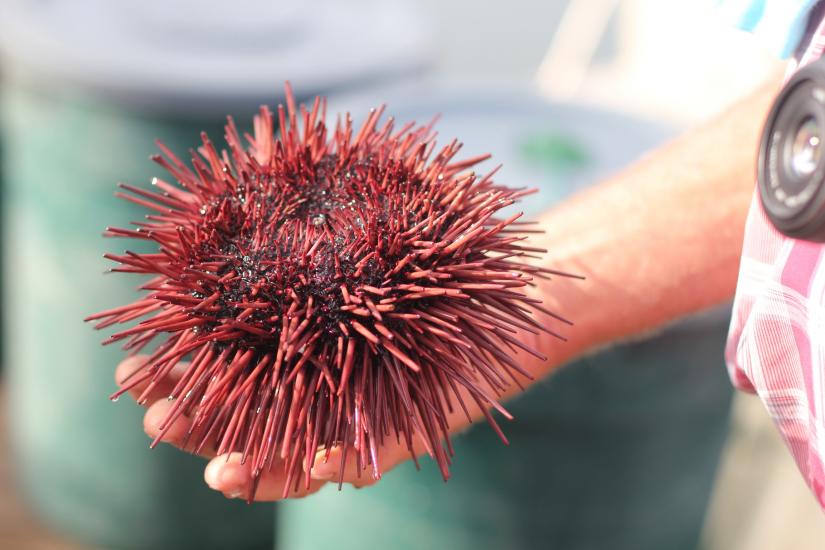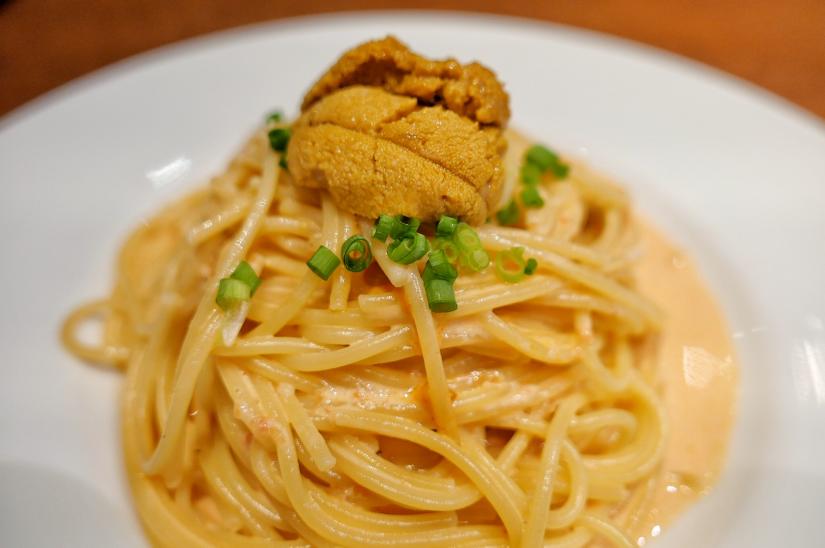Red Sea Urchin
Strongylocentrotus franciscanus
The Science
THE SCIENCE
Among its spines, the red sea urchin has two other types of arms: suctioning tube feet and claw-like pedicellaria used to grab food, move and clean themselves. Look closely!

Taxonomic description
- As an echinoderm, the red sea urchin is in the marine invertebrate group along with sea stars, brittle stars, and sea cucumbers.
- This is the largest species of sea urchin, and can grow to be 18 cm (7”) diameter with spine lengths of 8 cm (3”). [1]
- Dark red to black body color and large spines.
Distribution
- Found on the west coast of North America as far south as the tip of Baja California, Mexico. [2,3]
Life history
- Spawns year round and peaks June -- November in San Diego. [3]
- When eggs are fertilized they develop into free-swimming larvae for 6-8 weeks until they settle to the sea floor and become juveniles. [1]
- Larval and juvenile growth rates depend on water temperature.
- Can live up to 200 years, but most don’t. [4]
Habitat
- Lives from lower rocky intertidal to depths of 160 m (525 ft).
- A major food source for this urchin is kelp, so is common in kelp forests.
- In San Diego, main predators of the red sea urchin include spiny lobster & California sheephead; north of Pt. Conception the main predator is the sea otter. [2]
- Sensitive to water temperature changes as well as low salinity.
- Sea urchin feeding removes giant kelp, so it can structure the whole forest ecosystem.
The Fishery
THE FISHERY
The California sea urchin fishery began in 1970 and most were exported to Japan until ca. 2000, when the Japanese economic bubble burst and sea urchins became popular in domestic markets.

Seasonal availability
- In California, sea urchin is available year-round. [5]
Regulatory and managing authority
- As established by the Marine Life Management Act, the California Fish and Game Commission regulates the fishery, and the California Department of Fish and Wildlife manages this fishery in state waters. [11]
- The California Sea Urchin Commission and the Pacific Urchin Harvesters Association combines input from the industry and government entities to inform regulatory and management measures for this fishery. [12,13]
Gear type
- Fishers use hookah lines for diving to depths of 12-33 m (40-110 ft).
- Collected by hand from crevices using a rake and placed in a collection basket.
- In Southern California, red sea urchins must have a minimum test diameter of 3.25” (8.2 cm).
Status of the fishery
- There is little sustainability concern for local stocks at current level of exploitation & productivity.
- Current efforts partner scientists & local fishers to expand monitoring & attain a “profitable, sustainable, locally managed fishery”. [6]
- In 1987, after a 1970’s State control effort that left~75% of urchin population depleted in California [2], the industry initiated a moratorium on the fishery, including limited entry, seasonal closures & minimum size limits.
- Despite there being only 18 urchin divers in San Diego with an average age of over 50 years old, no new dive permits can be issued at this time.
Potential ecosystem impacts
- There are minimal impacts when the management strategy considers: (a) amount of sea urchin relative to kelp biomass. E.g., the local fishery may limit population booms that form sea urchin barrens, areas where all of the kelp has been eaten. (b) the harvest of only high quality (“fat”) sea urchins (≤50% of total), which leaves plenty behind to function in the ecosystem and “fatten up”.
- In areas with limited rocky substrate, juvenile urchins may depend on the spines of larger, adult urchins for shelter so high harvest rates may affect sea urchin recruitment in these conditions. [4]
The Seafood
THE SEAFOOD
Fishermen can predict the quality of sea urchins by “reading the bottom”, or assessing habitat conditions such as food supply, water movement, replenishment of sea urchins.


Edible portions
- The gonads of both male and female red urchins are a culinary delicacy, known as either “roe,”“uni” or “ricci del mar.”
- Gonad quality is ranked on the size, color, texture, taste, and firmness. [7]
Description of meat
- Roe, or uni, has smooth, buttery texture with a sweet, complex taste.
Culinary uses
- Local sea urchin is mostly available live or fresh.
- Cleaning and cracking the test (the shell) is manageable. Instructions can be found in multiple online resources. [10]
- Sea urchin can be prepared in many ways: Freshly cracked & eaten from the test, as sushi, like caviar on pasta, rice, seafood, crackers & cheese, as a flavor enhancer in soups, custards, and pasta dishes. [2]
- For a video tutorial on how to open sea urchin, visit Youtube. [14]
Nutritional information
- Sea urchin raw (3.5 oz). [8,9]
- It is a healthy source of omega 3 fatty acids and zinc. [9]
Toxicity report
- No known toxins.
Seasonal availability
- Year round.
References
[1] Red Sea Urchins, Mesocentrotus franciscanus ~ MarineBio.org." MarineBio Conservation Society. Web. https://marinebio.org/species/red-sea-urchins/mesocentrotus-franciscanu…. Accessed 8 July 2013.
[2] Tegner, M. J., P. K. Dayton. 1981. Population structure, recruitment & mortality of two sea urchins (Strongylocentrotus franciscanus and S. purpuratus) in a kelp forest. Mar Ecol Prog Ser 5: 255-268. Web. https://www.int-res.com/articles/meps/5/m005p255.pdf. Accessed 9 Sept 2020.
[3] Kato, S, S.C. Schroeter. 1985. Biology of the Red Sea Urchin, Strongylocentrotus franciscanus, and Its Fishery. California. Marine Fisheries Review 43: 1-20. Web. https://spo.nmfs.noaa.gov/content/biology-red-sea-urchin-strongylocentrotus-franciscanus-and-its-fishery-california. Accessed 10 Sept 2020.
[4] Ebert, T. 2003. Red sea urchins found to live up to 200 yrs. Science Daily. Web. http://www.sciencedaily.com/releases/2003/11/031106051646.htm. Accessed 10 Sept 2020.
[5] California Department of Fish and Wildlife. n.d. Invertebrates of Interest: Sea Urchin. Web. https://wildlife.ca.gov/Conservation/Marine/Invertebrates/Sea-Urchin. Accessed 10 Sept 2020.
[6] California Ocean Protection Council. Nov 2008. The San Diego Sea Urchin Project. Web. www.opc.ca.gov/webmaster/ftp/project_pages/CA_Fisheries/SDWA_Final_Report_NoAppendices.pdf. Accessed 10 Sept 2020.
[7] Leet, W.S., C.M. Dewees, R. Klingbeil, E.J.Larson, eds. 2001. California's Living Marine Resources: A Status Report. California Dept of Fish and Wildlife. Web. http://www.dfg.ca.gov/marine/status/status2001.asp. Accessed 10 Sept 2020.
[8] Fresh Raw-Sea Urchin Uni. n.d. myfitnesspal. Web. https://www.myfitnesspal.com/food/calories/sea-urchin-uni-199071965. Accessed 5 July 2020.
[9] Pacific Urchin Harvesters Association. 2013. Sea Urchin Nutritional Information. http://puha.org/nutritional-information/. Accessed 10 Sept 2020.
[10] Taste with the eyes. 2013. Web. http://www.tastewiththeeyes.com/2013/03/do-you-know-how-to-clean-a-sea-urchin/. Accessed 10 Sept 2020.
[11] Marine Life Management Act. n.d. California Department of Fish and Wildlife. Web. https://wildlife.ca.gov/Conservation/Marine/MLMA. Accessed 24 August 2020.
[12] Pacific Urchin Harvesters Association. Sea Urchin Nutritional Information. Web. http://puha.org/nutritional-information/. Accessed: 10 May 2017.
[13] California Sea Urchin Commission. n.d. Web. http://www.calurchin.org/about_us.html. Accessed 04 June 2017.
[14] Hawk, C. Youtube. 2015. 3 Ways to Crack an Urchin. Web. https://www.youtube.com/watch?v=_Au3Q-p7mfw. Accessed 2 Feburary 2021.
[15] Van Loon, C. & T. iNaturalist. 2021. Digital image. Web. https://www.inaturalist.org/photos/109815179. Accessed 23 February 2021.
[16] liamkmc. iNaturalist. 2021. Digital image. Web. https://www.inaturalist.org/photos/110343929. Accessed 23 February 2021.
[17] Hamano, H. flickr. 2019. 極上生ウニのトマトクリームパスタ. Digital image. Web. https://www.flickr.com/photos/mawari/48743239693. Accessed 23 February 2021.



